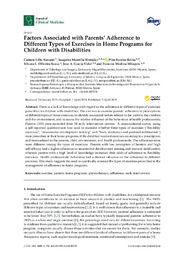Por favor, use este identificador para citar o enlazar este ítem:
https://hdl.handle.net/11000/37936Registro completo de metadatos
| Campo DC | Valor | Lengua/Idioma |
|---|---|---|
| dc.contributor.author | Lillo-Navarro, Carmen | - |
| dc.contributor.author | MONTILLA-HERRADOR, JOAQUINA | - |
| dc.contributor.author | ESCOLAR-REINA, Mª PILAR | - |
| dc.contributor.author | Oliveira-Sousa, Silvana Loana | - |
| dc.contributor.author | García Vidal, José Antonio | - |
| dc.contributor.author | Medina-Mirapeix, Francesc | - |
| dc.contributor.other | Departamentos de la UMH::Patología y Cirugía | es_ES |
| dc.date.accessioned | 2025-11-07T08:56:07Z | - |
| dc.date.available | 2025-11-07T08:56:07Z | - |
| dc.date.created | 2019-04 | - |
| dc.identifier.citation | Journal of Clinical Medicine, 8(4), 456 - April 2019 | es_ES |
| dc.identifier.issn | 2077-0383 | - |
| dc.identifier.uri | https://hdl.handle.net/11000/37936 | - |
| dc.description.abstract | There is a lack of knowledge with regard to the adherence to different types of exercises prescribed for children with disabilities. The aim was to examine parents’ adherence to prescriptions of different types of home exercises; to identify associated factors related to the parents, the children and the environment, and to assess the relative influence of the behaviour of health professionals. Parents (393) were recruited from 18 early intervention centres. A cross-sectional survey using a self-reported questionnaire was used to examine whether three types of exercises (“flexibility exercises”, “neuromotor development training” and “body mechanics and postural stabilisation”) were prescribed in their home programs; if the child had received exercises according to a prescription; and items related to the parents, child, environment, and health professionals. The adherence rates were different among the types of exercises. Parents with low perception of barriers and high self-efficacy had a higher adherence to neuromotor development training and postural stabilization, whereas parents with a high level of knowledge increased their odds of adherence to flexibility exercises. Health professionals’ behaviour had a distinct influence on the adherence to different exercises. This study suggests the need to specifically consider the types of exercises prescribed in the management of adherence to home programs. | es_ES |
| dc.format | application/pdf | es_ES |
| dc.format.extent | 13 | es_ES |
| dc.language.iso | eng | es_ES |
| dc.publisher | MDPI | es_ES |
| dc.rights | info:eu-repo/semantics/openAccess | es_ES |
| dc.rights | Attribution-NonCommercial-NoDerivatives 4.0 Internacional | * |
| dc.rights.uri | http://creativecommons.org/licenses/by-nc-nd/4.0/ | * |
| dc.subject | exercise | es_ES |
| dc.subject | parents | es_ES |
| dc.subject | home programs | es_ES |
| dc.subject | physiotherapy | es_ES |
| dc.subject | adherence | es_ES |
| dc.subject | early intervention | es_ES |
| dc.subject.other | CDU::6 - Ciencias aplicadas::61 - Medicina | es_ES |
| dc.title | Factors Associated with Parents’ Adherence to Different Types of Exercises in Home Programs for Children with Disabilities | es_ES |
| dc.type | info:eu-repo/semantics/article | es_ES |
| dc.relation.publisherversion | https://doi.org/10.3390/jcm8040456 | es_ES |

Ver/Abrir:
Factors Associated with Parents’ Adherence to Different Types of Exercises in Home Programs for Children with Disabilities.pdf
266,42 kB
Adobe PDF
Compartir:
 La licencia se describe como: Atribución-NonComercial-NoDerivada 4.0 Internacional.
La licencia se describe como: Atribución-NonComercial-NoDerivada 4.0 Internacional.
.png)